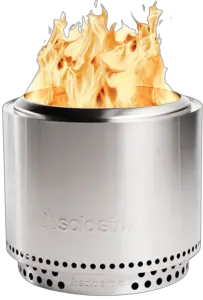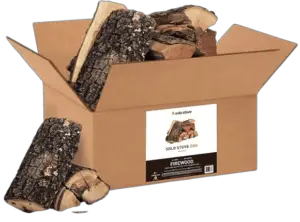Advantages and Disadvantages of Smokeless Fire Pits
Smokeless fire pits have gained popularity as an efficient and cleaner alternative to traditional fire pits. They promise the warmth and ambiance of a campfire without the irritation of smoke. But, like any outdoor investment, they come with both benefits and drawbacks. So, we have created this post to break down the key points to help you determine if a smokeless fire pit is the right fit for your outdoor space.
Advantages of Smokeless Fire Pits
Let’s start with the advantages of smokeless fire pits.
- Reduced Smoke and Improved Air Quality
It is important to know how the smokeless fits work. These fire pits are designed to minimize smoke, using a unique combustion process that burns fuel more completely. This means fewer emissions, creating a healthier environment for people with respiratory sensitivities. Reducing smoke also improves visibility around the fire, making gatherings more enjoyable.

- Better Fuel Efficiency
The advanced combustion technology in smokeless fire pits enables efficient fuel use, saving you money on wood, propane, or other fuels over time. The controlled burning process ensures consistent heat output without the need for more fuel, making it more economical in the long run.
- Versatile Design and Multi-Purpose Use
Smokeless fire pits are available in various styles, from portable fire pits ideal for camping to permanent installations for patios. Many models multitask serving multiple purposes beyond heating, such as grilling or roasting marshmallows, adding versatility to your outdoor gatherings. Certain smokeless fire pits even have aesthetic features that add a stylish touch to your garden or patio.
- Less Ash and Easier Maintenance
Since smokeless fire pits achieve more complete combustion, they produce less ash and residue compared to traditional fire pits. This means less frequent cleaning and easier maintenance, helping to keep your outdoor space neat and enjoyable.
- Enhanced Safety for Family-Friendly Use
With reduced smoke and controlled flames, smokeless fire pits are often safer for children and pets than traditional models. Many models feature safety screens or heat barriers to minimize contact with flames, creating a more secure environment.
Disadvantages of Smokeless Fire Pits
Let’s discuss the disadvantages of smokeless fire pits.
- Higher Initial Cost
One of the primary drawbacks is the higher upfront cost. Usually, these fire pits are expensive as compared to traditional fire pits. Smokeless fire pits often use advanced materials and technology, which can be pricier than basic traditional fire pits. However, this initial investment can be balanced out by long-term savings on fuel and reduced maintenance needs.
- Limited Heat Distribution
While smokeless fire pits are efficient, their design may direct most of the heat upward rather than outward, limiting warmth to people sitting close to the pit. This feature can be less ideal for larger groups who wish to feel the warmth from a distance, making traditional fire pits potentially better for certain gatherings.
- Complicated Maintenance and Fuel Constraints
While they may require less frequent cleaning, the maintenance of a smokeless fire pit can sometimes be more involved due to additional components like dampers and grates that control airflow. Additionally, some models may only work with specific fuel types, which can limit flexibility and require more planning.
- Aesthetic Concerns
For those who enjoy the rustic charm of a traditional campfire, smokeless fire pits may lack a bit of that appeal. Without the visible smoke and crackle of burning wood, the experience may feel more modern than authentic, which can be a drawback for some outdoor enthusiasts. Since many people love these crackles of burning wood, it can be a major disadvantage.
Choosing the Right Smokeless Fire Pit
When selecting a smokeless fire pit, consider factors like size, fuel type, and portability. A portable fire pit is ideal for those who frequently move their pit or take it on trips, while a built-in version provides a more permanent solution. Fuel type is also essential; while wood offers a classic feel, propane, and bioethanol options are cleaner and more manageable in urban settings.
Conclusion
Smokeless fire pits provide a cleaner, more efficient outdoor experience with advantages like reduced smoke, fuel efficiency, and added safety. However, the higher upfront cost, limited heat distribution, and specific maintenance requirements are factors to consider. If you prioritize eco-friendliness and a smoke-free environment, a smokeless fire pit may be well worth the investment. But for a more traditional experience and budget-friendly option, a classic fire pit might better suit your needs.
Frequently Asked Questions about Smokeless Fire Pits
Do Smokeless Fire Pits Really Work?
To put it briefly, yeah! Together, the pellet fuel and the airflow design create a genuinely smokeless fire that offers lots of warmth and a wonderful atmosphere. However, that doesn’t mean there aren’t any cautions to take into account. The first is that wood pellets often burn much faster than logs.
How Can I Make My Fire Pit Smokeless?
You can enjoy smokeless experience by using dry hardwoods. For effective and almost smokeless burning, use dry hardwoods like oak, maple, or birch. Steer clear of damp or green wood because it will smolder more easily and emit more smoke. Get the firewood ready. Correctly: To improve ventilation and speed up burning, break up the firewood into tiny pieces.
You can explore more about the best smokeless logs for fire pits.

What Is the Concept Behind Smokeless Fire Pits?
In addition to the flames from the burning wood inside the pit, a secondary burn is produced when colder air enters the fire through air inlets and outlets in the pit. The unburnt gases that would normally appear as smoke are consumed by the subsequent burn.
Do Smokeless Fire Pits Need More Maintenance?
No, they generally require less maintenance than traditional pits due to cleaner combustion but still need periodic ash removal and inspections.
Best Surface for a Smokeless Fire Pit?
Place on non-combustible surfaces like concrete or stone. Avoid wooden decks or grass without protective barriers.
Can I Convert My Traditional Fire Pit to Smokeless?
Some traditional pits can be converted with kits that enhance airflow. Check for compatibility before making changes.
Useful Accessories for Smokeless Fire Pits?
A cooking grate, protective cover, and fire glass or ceramic logs can enhance functionality, protection, and aesthetics.
Are Smokeless Fire Pits Safe for Kids and Pets?
Yes, they produce less smoke and contain flames better, but always supervise children and pets nearby. Adding a safety screen is helpful.
